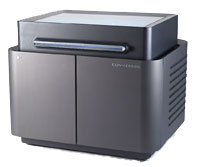ProE Administration
Changing Units System
Data transfer
Rapid prototyping
Laser cutting
Waterjet cutting
Rapid Prototyping [RP] in the Department
CAD Model
Your virtual model is about to become real. Before your model is exported for printing you will need to carefully consider how it is going to fit together and operate.
Where as previously you are likely to have ignored clearances between parts these will now have to be carefully considered and modelled - there is no such dimension as 10mm - all physical parts are created to a tolerance, don't allow your tolerances to create an interference fit. Any sort of fixing mechanisms such as screws or snap fits will have to be carefully considered
You will have to include appropriate clearances in your model. If you have details which need particular attention or are very small then maybe create a test piece which isolates that detail - particularly if the complete model has a significant cost.
Equipment
Dimension SST 1200
Objet Connex 500
To use either of these machines you will need:
An .stl file [see stl info here] - If you have exported from a non-parametric modeller [ie. Rhino or Alias] or you exported surfaces, you need to make sure that the .stl is 'manifold' or watertight. If there are any open single sided edges in the .stl then the volume is not closed and will not build.
Also make sure your file is at an appropriate level of detail for the end use. Fewer, large facets produce smaller, more handleable files but lack detail. Equally, more facets of a smaller size will give you more detail but will result in a large file size.
Detailed build information
Your individual part file size should not be greater than 10Mb - unless its physically a very big part your not going to see any extra resolution.
You will need to submit your .stl files to the filestore:
\\stud-fs\student-group\dtstore
and email Phil Dixon [cdprgd@lboro.ac.uk] with details of your requirements:
- Which RP machine [include
Dimension or Invision in the email subject line]
- File name [and where they are in the filestore]
- Quantity required
- Volume of the model in cm^3 - not mm^3
- Total volume for all parts required - remember your multiples
- Total cost @ 50p per cm^3 - minimum charge £1
Part volume
Analysis > Model Analysis > Model Mass Properties
Unless you want an exact mass leave the density as 1.
Move the decimal point appropriately to give cm3 [default is exponential figure in mm3]
Dimension SST 1200 [website]
This process is generally better for bulkier parts without fine detail or thin walls.
This Fusion Deposition Modeller extrudes a strand of ABS polymer to produce a boundary and then infill for each layer that the model is sliced into. It also creates a water soluble support structure.
This machine has a lower tolerance - +/-0.15mm - and is generally not good for small details. It lays a thread of extruded ABS which has a 'road width' of 0.5mm and layer thickness of 0.25mm.
The water soluble support structure has to be removed after the part is printed. Parts will be delivered with this process completed.

It has a reasonable definition. The strength is very dependent on the model geometry and build orientation - although the ABS model material has a good strength, failure will generally occur when the layers break apart.
The modelling time is dependent on the model volume and the amount of supports required.
Build volume 254 x 254 x 305mm
Layer resolution 0.254mm or 0.330mm
Tensile strength of ABS 40 MPa
Average model strength considering layering 22 Mpa
Density 1.05 g/cm3
Video: http://www.youtube.com/watch?v=cFcWFB0FlLo
Objet Connex 500 [website]

This machine gives good resolution and good accuracy, it also enables working mechanisms to be created and printed in several different materials at once. You can combine one rigid and one flexible material to give a range of Digital materials, each with their own physical properties, see here for material datasheets:
http://www.objet.com/Materials/Data_Sheets_Digital_Materials/
Materials we have on hand are:
Rigid materials:
VeroWhite (White)
Fullcure 720 (Transparent)
Flexible materials:
TangoBlack (Black)
TangoBlack+ (Black)
TangoPlus (Transparent)
Due to the high material cost when swapping from one base material to another, you may have to wait until the machine is loaded with the correct material to suit your requirement.
All materials are UV cured and have an operational temperature ~50°C, any higher temperature tends to cause the model to warp and distort.
Maximum model size: D:490 W: 390 H: 200
Layer resolution: 0.03mm
Tensile Strength: Dependent on digital material created
Gel support material, remove by brushing, leaving to soak in water will cause the gel to swell and fall off. To remove any residue immerse in a 5% sodium solution, then brush & rinse.
